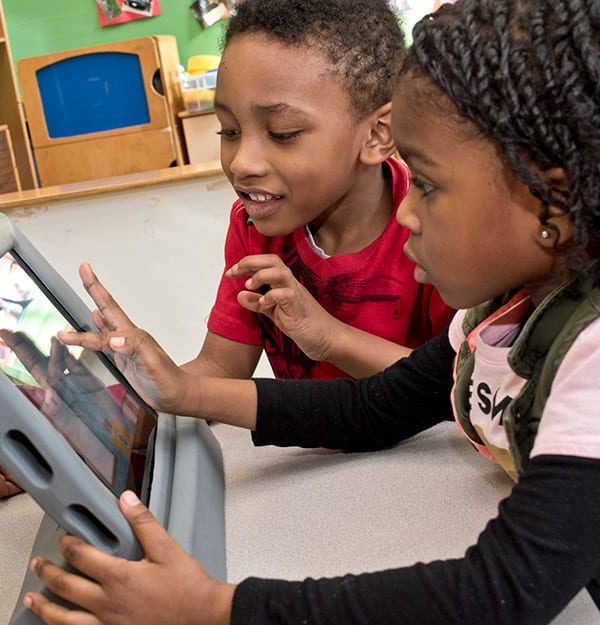Written by: Fashina Aladé, Assistant Professor, Michigan State University, and Alexis Lauricella, Assistant Professor, Erikson Institute, Director, TEC Center
“I heard that the kids should play iPad games instead because playing games is interactive, not passive like TV.” –Father of 4 children
We’ve all heard this argument before. The idea that playing an interactive app on an iPad or tablet is better for children than watching TV passively has become pervasive amongst parents, educators, and policymakers. School districts around the country are spending millions of dollars to ensure that every student has access to their own Chromebook or tablet. And now with a multitude of colorful, drop-proof, spill-proof “kiddie tablets”, it’s easier than ever for parents to equip their young children with the latest tech.
So what’s the verdict? Is interactive media really better for learning than “passive” media? Is it better to hand your child an iPad rather than sit them in front of the television? The short answer – not necessarily. Several recent research studies have shown that it really all depends on the content and the desired outcome. For example, in one study we conducted at Northwestern University’s Center on Media and Human Development, we had preschool aged children either play an interactive game on a tablet or watch a non-interactive video that displayed the exact same content. The game was designed to teach children how to do approximate measurement, a foundational early math skill that children are expected to know by the time they enter first grade (National Council of Teachers of Mathematics).
The children in our study either played the game using their fingers to click and drag socks and baseball bats over to a measuring line to measure how tall and wide each zoo animal was (“interactive”), or they watched a pre-recorded video version of the game that essentially mimicked a segment of an educational television program (“passive”).
Then we tested the children on a real-world measuring task that had three levels. At the easiest level, or what developmental psychologists call near transfer, the task was very similar to what the children saw on screen. At the medium level, the task was mostly similar but with some differences. And at the hardest level, the task was quite different from the game, but still relied on the basic skill of approximate measuring.
It seems as though children in the passive condition were better able to understand the measurement lesson in a more holistic way, which allowed them to apply what they learned to new contexts. Other studies have shown similar results. Researchers at the University of Wisconsin Madison had preschoolers play one science game and watch an experimenter play a different game. Children were able to transfer skills from the game that they watched, but not from the game that they played.
So what’s going on here? It turns out that the word “passive,” when referring to young children and watching television, is a massive misunderstanding. Yes, children watch TV with their “eyes glued to the screen.” Yes, sometimes they don’t respond when you try to talk to them. Yes, sometimes their mouths flop open as they stare. Yes, this can be an unsettling sight for parents. Does all of that mean that this is a passive activity, with little to no interaction? Actually, no—it means they are engaged. They are processing.
There has been a recent push by Dan Anderson at the University of Massachusetts Amherst, a leading developmental psychologist and educational media expert, to start referring to television and the like as “receptive media” rather than passive media, in order to more accurately reflect the fact that our brains are still highly activated when we watch television. This is all the more true for young children. Their tiny developing brains are working really hard to put together the impressively fast screen shots, video montage, and complex storylines. So when you add in another complex dimension such as motor interactivity, it may just be too much for them to handle.
It’s important to note that most of these findings pertain specifically to pre-school aged children. It may be the case that interactive media really does hold more learning potential for older children and adolescents. But for our youngest media users, especially in the years prior to formal schooling, the research suggests that a well-designed, research-backed educational television program may offer just as much learning potential as a well designed tablet app. Moreover, rather than debating which tech is better, we need to move the argument towards asking which tech is better for which types of learning, so that we can better leverage all of the technology available for children today in a way that truly benefits their growth and development.
Please use the following citation for reference:
Aladé, F. and A. R. Lauricella (2019, June 14). The Great Interactive Debate – How Does Interactivity Really Impact Learning? Erikson Institute’s Technology in Early Childhood Center. https://www.erikson.edu/news/the-great-interactive-debate/

References
Aladé, F., Lauricella, A. R., Beaudoin-Ryan, L., & Wartella, E. (2016). Measuring with Murray: Touchscreen technology and preschoolers’ STEM learning. Computers in Human Behavior, 62, 433–441. Available here
Anderson, D. R. and M. C. Davidson (2019). “Receptive versus interactive video screens: A role for the brain’s default mode network in learning from media.” Computers in Human Behavior 99: 168-180.
Schroeder, E. L. and H. L. Kirkorian (2016). “When Seeing Is Better than Doing: Preschoolers’ Transfer of STEM Skills Using Touchscreen Games.” Frontiers in Psychology, 7. doi: 10.3389/fpsyg.2016.01377

Join the Erikson family with monthly news + events updates shared by academics, community members, and families.